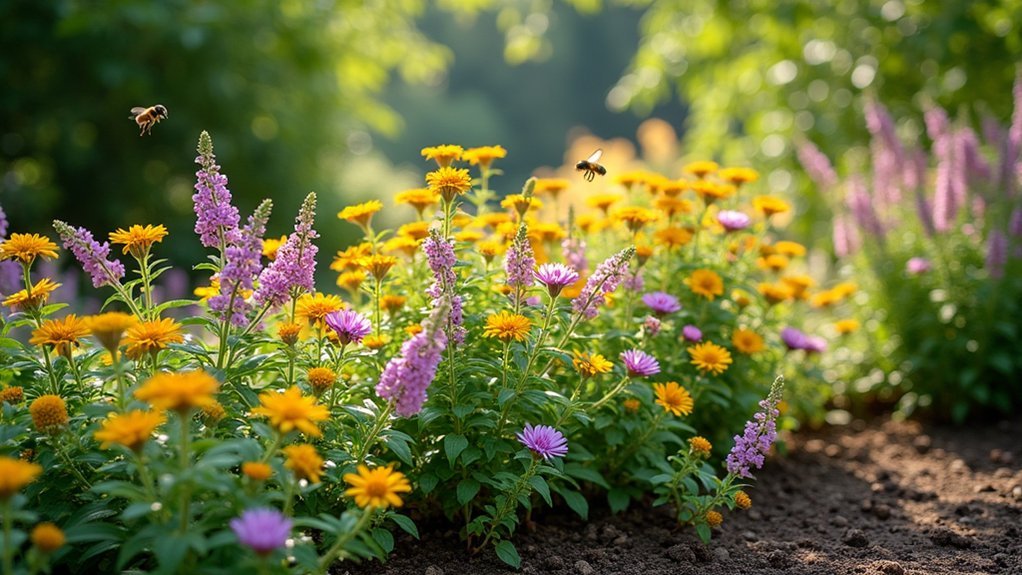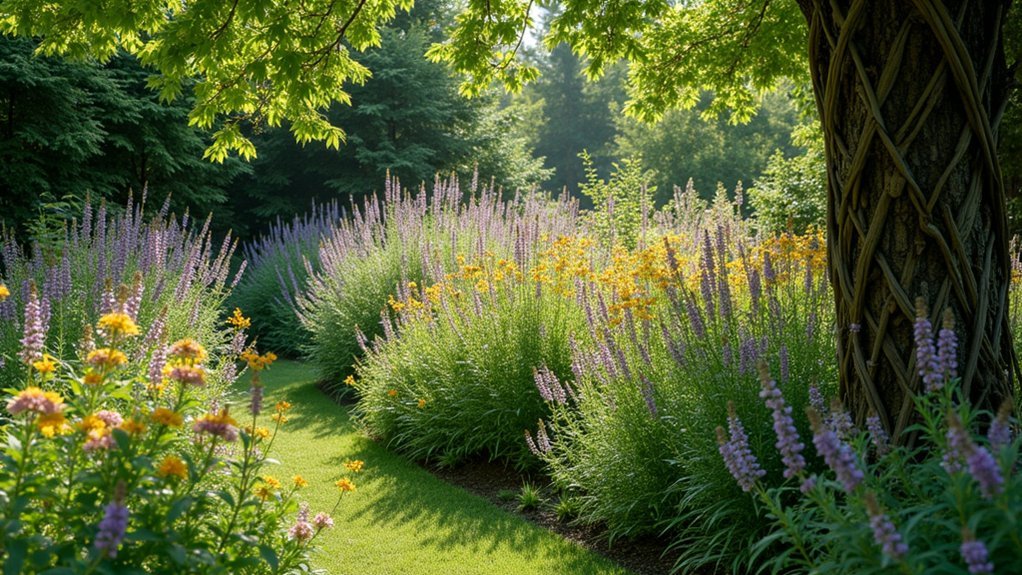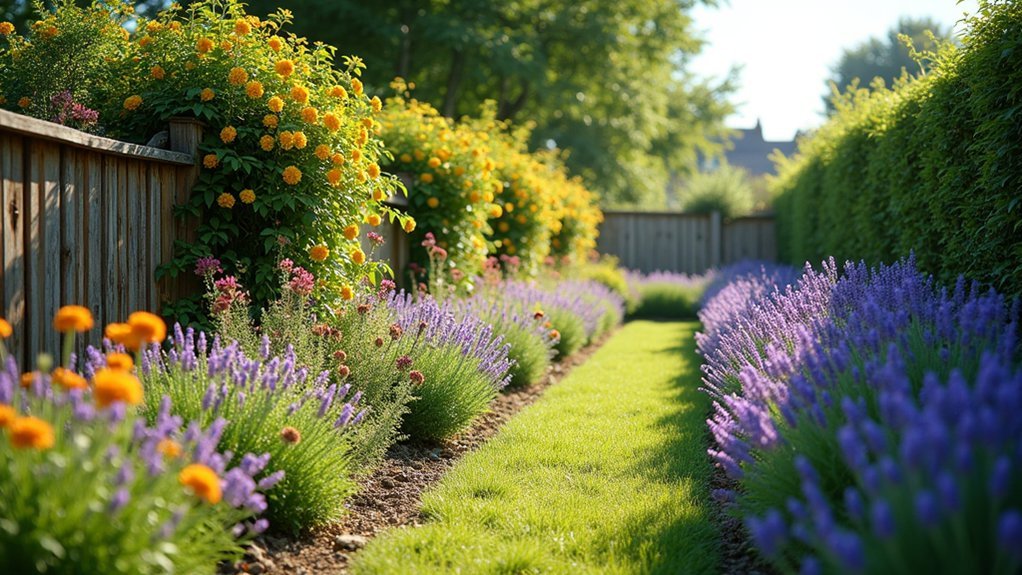The best bee-friendly garden boundaries include flowering native shrub borders with nectar-rich plants like buttonbush and New Jersey tea, layered hedgerows with staggered blooming periods, and living fences that combine beauty with ecological function. You’ll create thriving micro-ecosystems that support specialist bees while enjoying lower maintenance needs and superior pest resistance. Plant in odd-numbered groupings for visual appeal and include various heights for nesting and foraging spaces. Discover how these boundaries transform your garden into a pollinator paradise.
Flowering Native Shrub Borders That Buzz With Life

While many gardeners focus solely on flowers to attract pollinators, native shrubs offer a powerful multi-purpose alternative for your garden boundaries. These woody perennials create living fences that serve double duty—defining spaces while supporting local bee populations.
Choose plants like buttonbush and New Jersey tea that thrive in full sun and produce nectar-rich blooms irresistible to bees and butterflies. Specialist bees depend on particular native shrubs for their survival, making these plantings essential for preserving local pollinator diversity. By selecting varieties with staggered flowering periods, you’ll provide continuous forage throughout growing seasons.
Native shrubs require less maintenance than exotic varieties while offering superior pest resistance without chemicals. Their deep root systems improve soil health and conserve water, making them climate-smart choices.
For maximum impact, plant them in groups to create microclimates that shelter pollinators and provide nesting habitat year-round.
Layered Hedge Alternatives For Maximum Pollinator Support
Unlike traditional single-species property borders, layered hedgerows transform your garden boundaries into thriving ecosystems for pollinators. These multi-tiered plantings create complex habitats where bees, butterflies, and beneficial insects can nest, rest, and forage throughout the seasons.
Design your hedgerow with staggered arrangements combining evergreens, deciduous shrubs, and flowering perennials. Using grouped plant sets in odd numbers creates visual consistency while maintaining biodiversity throughout your bee-friendly boundary. Include plants from the Umbelliferae family to attract pest-controlling insects, and guarantee varied bloom times for continuous nectar sources.
| Layer | Benefits | Plant Examples | Pollinator Support |
|---|---|---|---|
| Canopy | Wind protection, nesting sites | Serviceberry, Redbud | Early spring nectar |
| Shrub | Foraging zones, shelter | Blueberry, Elderberry | Summer food sources |
| Herbaceous | Diverse bloom periods | Yarrow, Lavender | Abundant nectar access |
| Ground | Overwintering habitat | Oregano, Thyme | Nesting material, protection |
These living boundaries not only beautify your property but create essential ecological corridors supporting pollinator migration and survival.
Living Fences That Combine Beauty And Biodiversity

Living fences transform ordinary boundaries into works of living art that serve both aesthetic and ecological functions.
You’ll create micro-ecosystems that shelter small animals and attract beneficial pollinators like bees and butterflies when you plant diverse species as natural barriers.
Beyond their beauty, these green boundaries offer significant environmental benefits by sequestering 600-800 pounds of carbon annually when mature, while filtering air pollutants.
Living fences are climate champions, capturing carbon and purifying our air with every leaf and branch.
Their extensive root systems prevent soil erosion and stabilize slopes effectively.
You’ll also enjoy economic advantages—mature hedgerows cost 60-80% less to maintain than wooden fencing and can yield $15-25 per linear foot when you incorporate edible plants.
Consider native berry-producing shrubs or aromatic herbs like rosemary and lavender for a boundary that’s not just beautiful but sustainable and productive. The thorny species like barberry and hawthorn not only provide excellent nectar sources but also create natural security barriers that discourage unwanted visitors.
Frequently Asked Questions
How Do I Protect Bee-Friendly Boundaries From Deer and Rabbits?
You’ll need physical barriers like 8-foot fencing for deer and mesh chicken wire buried 6 inches deep for rabbits. Plant rabbit-resistant herbs like thyme and use strong-smelling deterrents such as predator urine.
Can Bee-Friendly Boundaries Work in Shaded Garden Areas?
Yes, you can create bee-friendly boundaries in shaded areas! Choose shade-tolerant plants like Jacob’s ladder, bleeding heart, and hellebores. They’ll attract pollinators while requiring less water and providing beautiful multi-season interest.
What’s the Minimum Width Needed for an Effective Pollinator Border?
For an effective pollinator border, you’ll need a minimum width of 6 feet for garden settings, though wider is better. Aim for 100 feet if you’re creating larger conservation habitats to support diverse pollinator populations.
How Quickly Will These Living Boundaries Establish Privacy Screens?
You’ll see privacy developing in 2-3 months with fast-growing plants like sunflowers, which reach 6 feet in 60-90 days. For year-round coverage, combine annual and perennial species with staggered bloom times.
Are There Bee-Friendly Options for Formal Garden Designs?
You’ll achieve formal designs through structured plant groupings, symmetrical layouts, and defined borders. Use native goldenrod, lyreleaf sage, and sourwood trees, while incorporating stone walls that provide both visual structure and bee nesting sites.
In Summary
Your garden’s boundaries don’t have to be lifeless barriers. By choosing flowering native shrubs, layered pollinator-friendly hedges, or living fences, you’ll create vibrant ecosystems that bees can’t resist. These alternatives offer beauty, privacy, and essential habitat for our declining pollinators. Make the switch today—your garden’s edges will buzz with activity while supporting local biodiversity. It’s a simple change with powerful environmental impact.





Leave a Reply